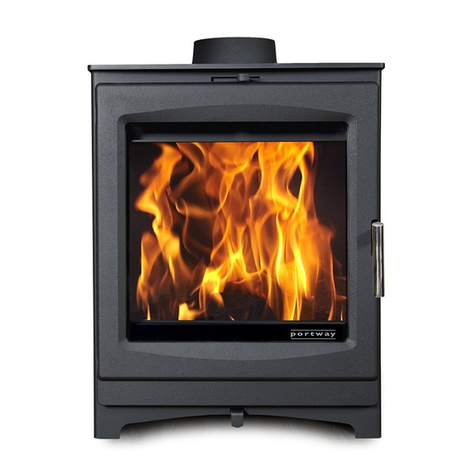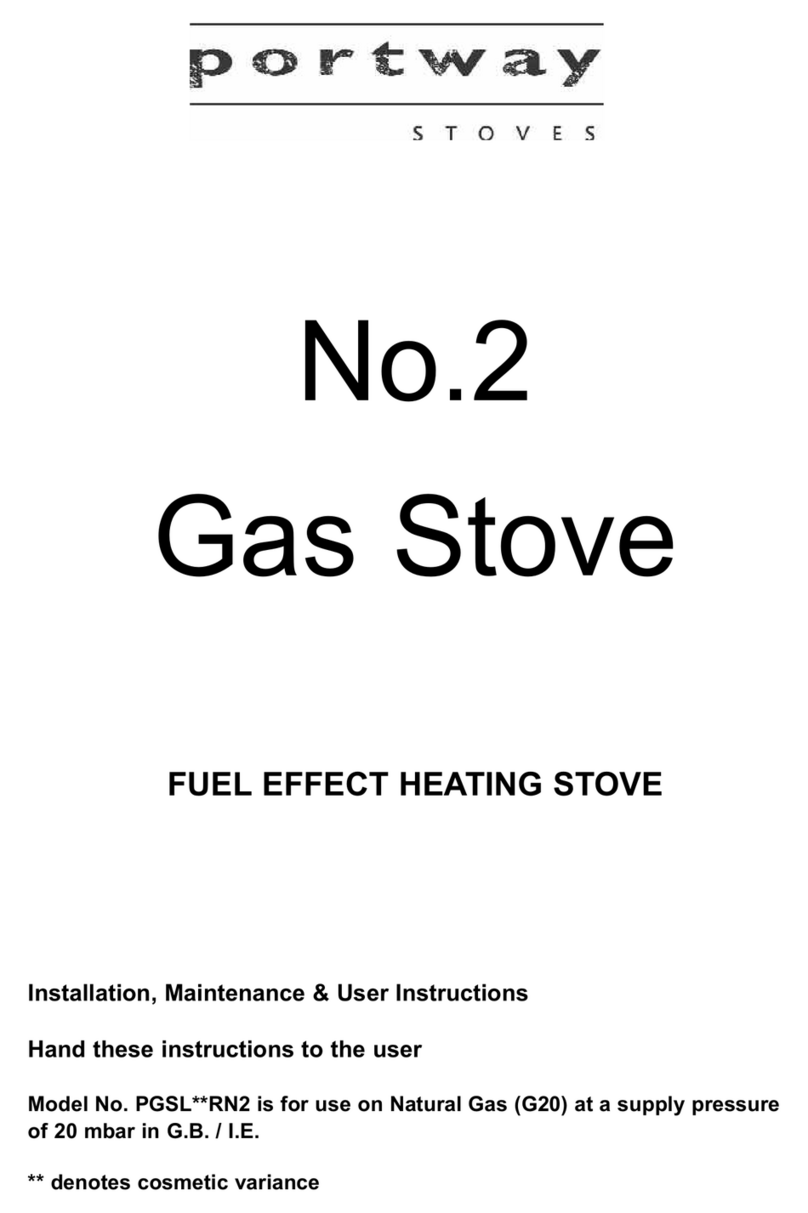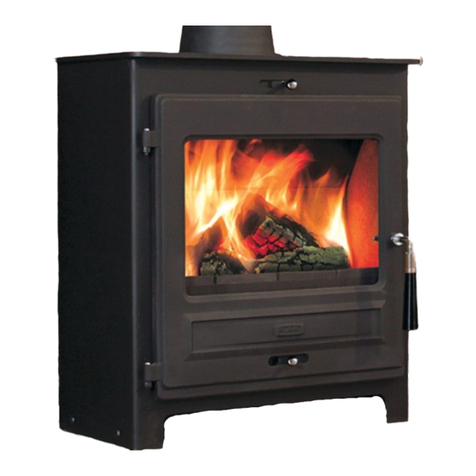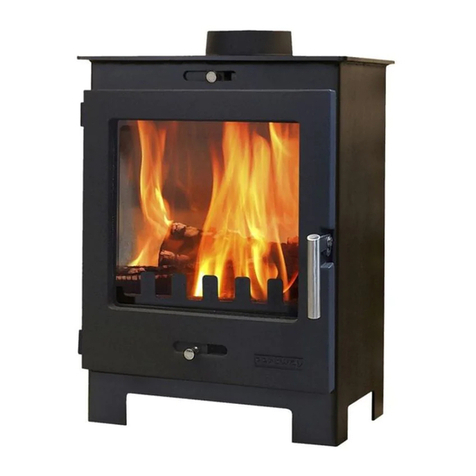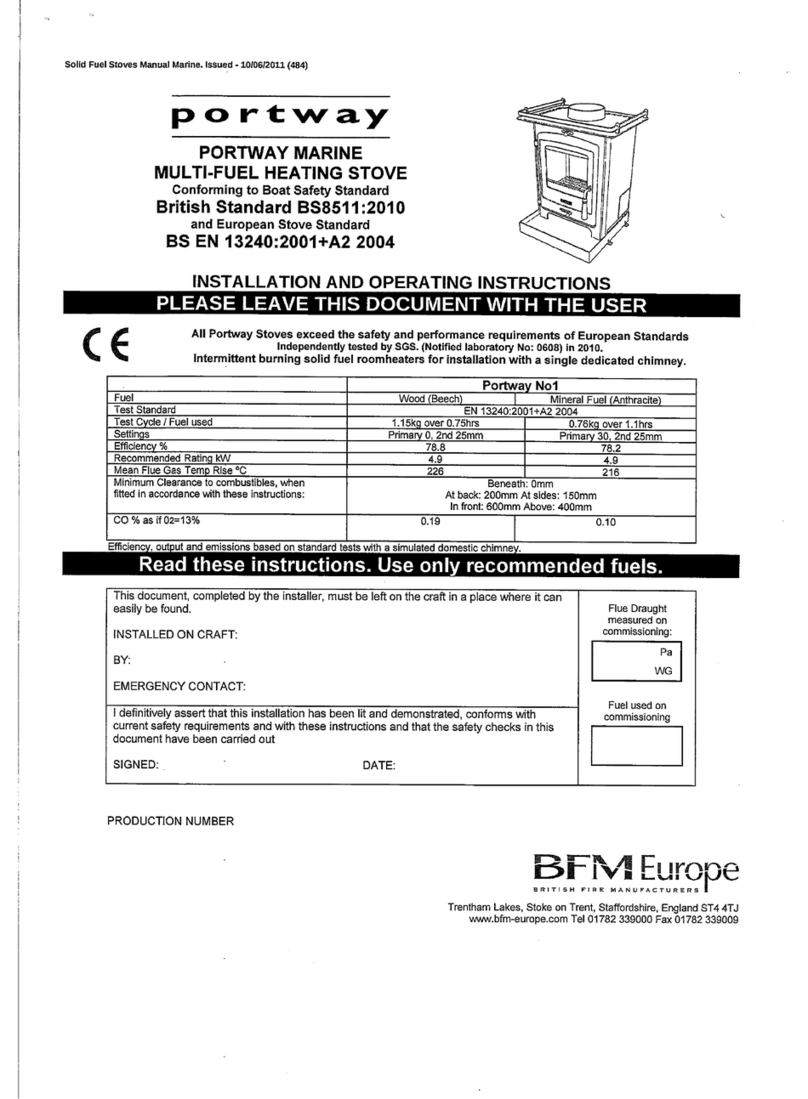IN 1830 Charles Portway built a stove to heat his ironmongery shop at Halstead in Essex. It was so good that his neighbours
started asking for them. Mr Portway had done something completely new designed his stoves right from the start to give out
the maximum heat from the minimum fuel, so that he is known as "The Founding Father of Energy Efficiency". The stoves
that bear his name are still made in Britain by the direct successors of the company he established.
Building regulations are available at www.soliftec.com
INST LLING a stove is a 'controlled service', the law expects that it is
either supervised by a qualified installer or that the building inspector is
informed. Check with your local authority.
SBESTOS: Your stove does not contain asbestos, but take care to
avoid disturbing asbestos in an old installation.
WEIGHT: Your stove is heavy - take great care when moving it and
ensure that the intended fireplace can support the weight- consider
fitting a load distributing plate.
YOUR CHIMNEY, by becoming warm, makes the gas inside it rise,
pulling fresh air into the stove to make it work. It must:
●Generate a draught in use of at least 12Pa (0.05ins wg)
●Be capable of withstanding the temperatures generated.
●Be absolutely incapable of leaking fumes into the dwelling
This may commonly be achieved by it:
●Being at least 5m high.
●Terminating at least 1m above any roof ridge.
●Having an internal cross-section equivalent to not less than
150mm diameter, and never more than 0.14m² (eg 375 x 375mm)
●Being free from even the slightest crack or source of leakage.
●Having no bends sharper than 45º.
●Being swept and entirely free of obstructions
●Being connected only to this one appliance.
●Being of thick masonry or otherwise adequately insulated.
●Conforming to local building regulations.
Special rules apply where the flue passes through timber, thatch or
other vulnerable materials- take specialist advice.
Although it is possible to access the chimney through the fire with the
baffle removed, fit hatches to provide access if needed.
YOUR FIREPL CE: Stoves become VERY hot, the setting must be
made entirely of durable fireproof materials. Thin (<50mm) stone slabs
risk cracking unless cut into sections to allow for expansion and
backed with a heat resistant concrete. Even beyond the safety
clearance items can still become very hot - take great care in siting
wax, paper etc. Inset convector stoves deliver very hot air into the
room, so that the 350mm clearance above to combustible materials
must be strictly observed.
FRONT HE RTH: To guard against fallen embers and protect against
fire we recommend a solid non-combustible hearth, which may simply
be an area of solid flooring, extending at least 300mm in front of the
appliance, no matter at what height the stove is fitted.
IR SUPPLY: Your stove needs air to breathe - there must be a
permanent fresh air supply to the stove, provided either by:
(1) AIR SUPPLY FROM OUTSIDE THE BUILDING:
Remove the rear air port and fit connector and 75mm flexi air supply
tube direct to outside. Make sure the inlet can't be blocked by snow,
rodents, etc.
(2) AIR SUPPLY IN THE ROOM:
Remove the front air port. There should be an air supply from outside
the building into the room in which the stove is installed equal to about
550mm² for each kW of output. This can often be provided by air
leaking around door frames etc. (it is commonly accepted that this
alone may suffice for appliances <c.5kW) but in any case of doubt, fit a
purpose-made air vent. An extractor fan, or another fuel-using
appliance in the same building, can remove this air.
FITTING
The stove must be fixed down to the solid hearth through the two points under the base insulation panels. It may be connected to the chimney
flue in many different ways, three of which are shown here. If required, the lower frame bar ('LFB') may be removed.
◄ 'FREE INSET' or 'CASSETTE'
METHOD (3):
The stove is fitted inside a hollow chimney
breast which is ventilated to the room at
high and low levels, creating extra hot air
circulation. The stove flue is connected to
the chimney using up to 1.5m of
uninsulated flue pipe.
CONVECTION
This Portway stove is not just a
'firefront' or a simple 'inset stove',
but a genuine hot-air convector
fire. It has a very precisely
shaped, sealed chamber,
behind, above and underneath
the fire to collect heat and
naturally force a stream of
extremely hot air into the room,
to evenly heat every corner.
'FIREPLACE SEAL' METHOD (4): ►
Fix the stove and, through the flue outlet,
fill any gap behind with vermiculite
granules topped with mortar. Carefully
check that the fire has an absolutely
airtight seal against the fireplace.
'CHIMNEY SEAL' METHOD (5): ►
Remove the round connector. Fit the flue
pipe, or flexible liner with a 150mm
adaptor, into the chimney and seal its
loose end to the round connector with fire
cement. Fix the stove. Bolt the connector
and pipe back in place from inside. Check
that the pipe forms a clear route from stove
to chimney terminal with no leaks into the
masonry space.
Whichever method is used it is imperative that: (1) The route for gases from the stove to the chimney terminal is completely air-tight; even the
tiniest gap or crack can spoil the updraught. Seal all joins with fireproof cement and/or heatproof rope. (2) It is possible to sweep the entire
length- access doors may be required. (3) The entire construction is of durable fireproof materials. (4) Fit a CO alarm!
2
present. The installer is required to EX CTLY follow
local, national and international standards.
